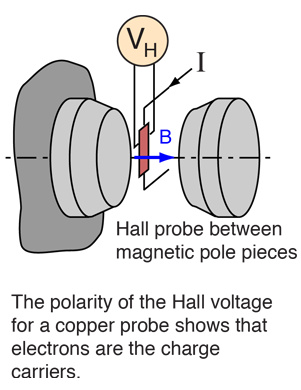Hall Effect
If an electric current flows through a conductor in a magnetic field, the magnetic field exerts a transverse force on the moving charge carriers which tends to push them to one side of the conductor. This is most evident in a thin flat conductor as illustrated. A buildup of charge at the sides of the conductors will balance this magnetic influence, producing a measurable voltage between the two sides of the conductor. The presence of this measurable transverse voltage is called the Hall effect after E. H. Hall who discovered it in 1879.
Note that the direction of the current I in the diagram is that of conventional current, so that the motion of electrons is in the opposite direction. That further confuses all the "right-hand rule" manipulations you have to go through to get the direction of the forces.
 |
The Hall voltage is given by
where n = density of mobile charges and e = electron charge. The Hall effect can be used to measure magnetic fields with a Hall probe. |
| Hall probe for magnetic field measurement |
Magnetic force applications
Magnetic field concepts
| HyperPhysics***** Electricity and Magnetism | R Nave |

